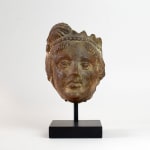Terracotta Mask of a Ptolemaic King, 200 BCE - 50 CE
Terracotta
height 21 cm
height 8 1/4 in
height 8 1/4 in
PF.6113
Further images
Following the death of Alexander the Great, his empire was divided between his three generals, each of whom set up their own kingdoms. One of them, Ptolemy, took Egypt as...
Following the death of Alexander the Great, his empire was divided between his three generals, each of whom set up their own kingdoms. One of them, Ptolemy, took Egypt as his share and made Alexandria his capital. Ruling as Ptolemy I Soter, he established the last dynasty to rule Egypt with the title of Pharaoh. For the next two and a half centuries, the Ptolemaic Dynasty of Greeks controlled Egypt, mingling Hellenic traditions with the mighty legacy of the Pharaohs.
This stunning terracotta mask reveals the intermingling of native Egyptian and Greek artistic traditions. Depicting an individual wearing a serrated crown, this mask likely represents one of the Ptolemaic Kings, possible Ptolemy XII. Although King Ptolemy XII ruled Egypt from 51 until 47 B.C., he is perhaps best known for his unsuccessful attempts to rout his sister (and wife), Cleopatra, from power. Originally, they shared acting power as husband and wife, until conflicts between them forced Ptolemy to exile Cleopatra from Egypt. Civil war broke out as each side formed their own army; Ptolemy allied with the Roman general Pompey the Great. Following the death of Pompey, there was a brief moment of reconciliation between brother and sister. However, shortly thereafter, Cleopatra became the mistress of Caesar, and with his assistance, consolidated her power in Egypt and had Ptolemy executed. Gazing upon this work or art, might we be confronted with the face of this tragic King? Although his reign was brief and marked by internal struggles and civil war, one only sees the extraordinary legacy of Egyptian and Hellenic cultures merged together in this remarkable mask.
This stunning terracotta mask reveals the intermingling of native Egyptian and Greek artistic traditions. Depicting an individual wearing a serrated crown, this mask likely represents one of the Ptolemaic Kings, possible Ptolemy XII. Although King Ptolemy XII ruled Egypt from 51 until 47 B.C., he is perhaps best known for his unsuccessful attempts to rout his sister (and wife), Cleopatra, from power. Originally, they shared acting power as husband and wife, until conflicts between them forced Ptolemy to exile Cleopatra from Egypt. Civil war broke out as each side formed their own army; Ptolemy allied with the Roman general Pompey the Great. Following the death of Pompey, there was a brief moment of reconciliation between brother and sister. However, shortly thereafter, Cleopatra became the mistress of Caesar, and with his assistance, consolidated her power in Egypt and had Ptolemy executed. Gazing upon this work or art, might we be confronted with the face of this tragic King? Although his reign was brief and marked by internal struggles and civil war, one only sees the extraordinary legacy of Egyptian and Hellenic cultures merged together in this remarkable mask.





